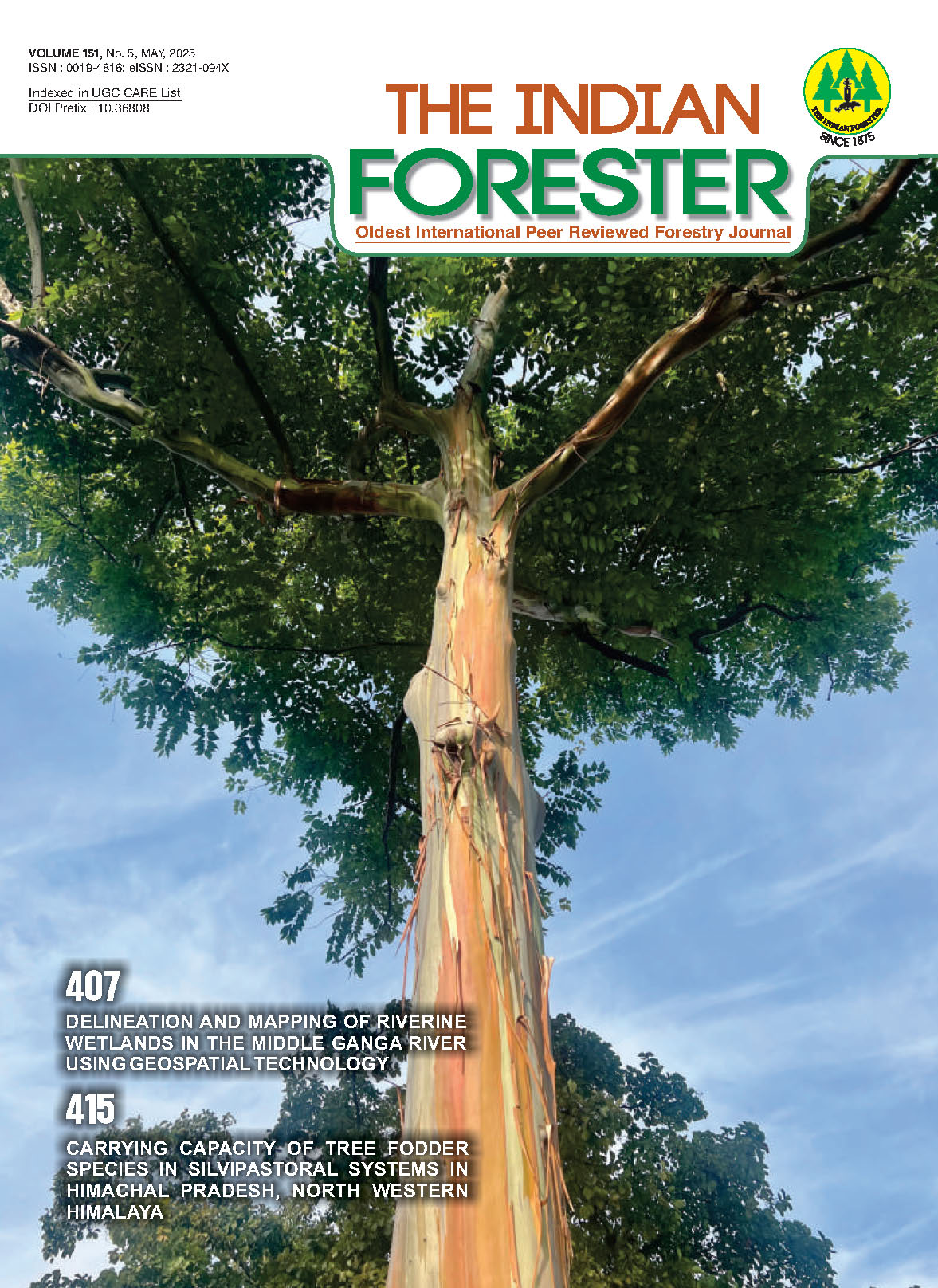Effect of IBA on Rooting Behaviour of Melia dubia Cuttings
DOI:
https://doi.org/10.36808/if/2025/v151i5/170084Keywords:
IBA hormones, Softwood, Semi-hardwood, Cuttings, Rooting behaviour.Abstract
This study investigated the effects of varying concentrations of Indole-3-butyric acid (IBA) on the sprouting, rooting, and biomass of Melia dubia cuttings. Softwood and semi-hardwood cuttings were treated with IBA concentrations of 400, 800, 1200, and 1600 ppm, with untreated cuttings serving as controls. Results indicated that IBA significantly enhanced the sprouting time, number of cuttings sprouted, survivability, and shoot and root development. The 1200 ppm IBA treatment (T3) demonstrated the fastest sprouting time of 6.17 days, the highest number of sprouts (11.5), and the greatest shoot length (20.5 cm). Softwood cuttings (S2) outperformed semi-hardwood cuttings (S1), particularly when combined with higher IBA concentrations. The combination of 1600 ppm IBA with softwood cuttings (T4S2) achieved the quickest sprouting time (4.3 days) and the highest number of sprouts (14). Root development was most substantial in cuttings treated with 1200 ppm IBA, showing a root length of 13.5 cm and 63 roots per cutting. Biomass accumulation was also highest in cuttings treated with 1200 ppm IBA, with a fresh shoot weight of 12.9 grams and a dry shoot weight of 7.57 grams. These findings underscore the critical role of IBA in enhancing the propagation success of Melia dubia cuttings.
References
Carvalho M.D. Zaidan L. and De C.M. (1995). Propagation of Stevia rebaudiana from stem cuttings Persquisa Agropecuaria Brasileira, 30: 201-206.
Chandra J.P. and Joshi B.C. (1994). Performance of exotic poplar clones in Taras (Uttar Pradesh). Indian Forester, 120(2): 110-118.
Chhun T., Taketa S., Tsurumi S. and Ichii M. (2003). The effects of auxin on lateral root initiation and root gravitropism in a lateral rootless mutant Lrtl of rice (Oryza sativa L.), Plant Growth Regulation, 89(4): 161-170. DOI: https://doi.org/10.1023/A:1022592511387
Gehlot A., Gupta R.K., Tripathi A., Arya I.D. and Arya S. (2014). Vegetative propagation of Azadirachta indica: effect of auxin and rooting media on adventitious root induction in mini-cuttings. Advances in Forestry Science, 1(1): 1-9. DOI: https://doi.org/10.34062/afs.v1i1.1357
Kesari V., Krishnamachari A. and Rangan L. (2009). Effect of auxins on adventitious rooting from stem cuttings of candidate plus tree Pongamia pinnata (L.), a potential biodiesel plant. Trees, 23(3): 597-604. DOI: https://doi.org/10.1007/s00468-008-0304-x
Lal P., Kulkarni H.D., Srinivas K., Venkatesh K.R. and P. Santha Kumar (1997). Genetically Improved Clonal Planting Stock of Eucalyptus- A Success Story from India. Indian Forester, 123 (12): 117-138.
Mahmood K.A., Othman O.A. and Nashat Maulood A.R. (2017). Effect of cutting type and Seradix 3 on rooting percentage and some characteristics of produced Paulownia's sapling Paulownia tomentosa L. Journal Tikrit Univ. For Agri. Sci., 17(3): 1-8.
Mathur R.S. and Sharma K.K. (1983). Poplars in India. Indian Forester, 109 (9): 591- 631
Parthiban K.T., Akilesh Kumar Bharathi, R. Seenivasan, K. Kamala and M. Govinda Rao (2009). Integrating Melia dubia in Agroforestry farms as an alternate pulpwood species. Asia-Pacific Agroforestry Newsletter, 4: 34.
Parthiban K.T., Scenivasan R. and M. Govinda Rao (2010). Contract Tree Farming A successful Industnal Farm Forestry approaches. Indian Forester, 136 (2): 187-197.
SarwarJahan, M. Nauma Chowdhury and Yonghaoni (2010). Effect of different locations on the morphological, chemical, pulping and paper making properties of Trema rentals (Nalita). Bioresource Technology, 101: 1892-1899. DOI: https://doi.org/10.1016/j.biortech.2009.10.024
Sivakumar B., Afaq M.W. (2014). Effect of intergrated nutrient management on biomass production and nutrients uptake in Dendrocalamus strictus (Roxb) Ness under nursery condition. International Journal of Farm Sciences, 4(1): 42-49.
Topacoglu O., Sevik H., Guney K., Unal C., Akkuzu E. and Sivacioglu A. (2016). Effect of rooting hormones on the rooting capability of Ficus benjamina L. cuttings. Šumarski list, 140(1-2): 39-44. DOI: https://doi.org/10.31298/sl.140.1-2.4
Warrier Rekha R. (2014). Cultivation Techniques for Melia dubia, In Transfer of Tree Cultivation Technologies to Krishi Vigyan Kendras (KVKs) of Tamil Nadu and Puducherry, pp-16.
Downloads
Downloads
Published
How to Cite
Issue
Section
License
Unless otherwise stated, copyright or similar rights in all materials presented on the site, including graphical images, are owned by Indian Forester.





